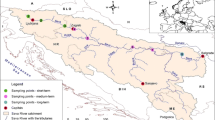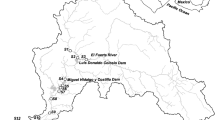Abstract
Nutrient enrichment from nonpoint source pollution is one of the main causes of poor water quality and biotic impairment in many streams and rivers worldwide. The establishment of reference nutrient conditions in a river system is an essential but difficult task for water quality control. In the present study, the reference concentrations of total nitrogen (TN) and total phosphorus (TP) were estimated in an intensive agricultural watershed, the Cao-E River system of Eastern China. Based on a 3-year water quality monitoring data in the river system, three approaches were adopted to establish the reference concentrations of TN and TP, those are the 75th percentile of frequency distribution of nutrient concentrations in reference streams, the 25th percentile of frequency distribution of nutrient concentration in general streams (including reference and non-reference streams) and regression modeling. Results showed that the nutrient reference concentrations were slightly different from different approaches. By the three approaches, the average reference concentrations for TN and TP in the study system were 1.73 ± 0.13 mg l−1 and 55.23 ± 4.77 μg l−1 with CV of 7.39 % and 8.63 %, respectively. Accordingly, the reference concentrations for TN and TP were recommended to be 1.70 mg l−1 and 55 μg l−1, respectively. In the mountainous and intensive agricultural watershed, the major anthropogenic impacts to river water quality were the urban area percentage cover, cropland area with slopes 0–8°, and livestock and poultry waste loads density. These variables could account for 89.7 % and 80.3 % of the total variations for TN and TP concentration, respectively.



Similar content being viewed by others
References
Benoy GA, Brua RB, Culp JM, McGoldrick DJ, Chambers PA, Vis C (2011) Development of environmental thresholds for nitrogen and phosphorus in streams. J Environ Qual 41:7–20
Chambers PA, McGoldrick DJ, Brua RB, Vis C, Culp JM, Benoy GA (2011) Development of environmental thresholds for nitrogen and phosphorus in streams. J Environ Qual 41:7–20
Chen DJ, Lu J, Shen YN, Dahlgren RA, Jin SQ (2009) Estimation of critical nutrient amounts based on input–output analysis in an agriculture watershed of eastern China. Agr Ecosyst Environ 134:159–167
Ding X, Shen Z, Hong Q, Yang Z, Wu X, Liu R (2010) Development and test of the export coefficient model in the upper reach of the Yangtze River. J Hydrol 383:233–244
Dodds WK (2007) Trophic state, eutrophication and nutrient criteria in streams. Trends Ecol Evol 22:669–676
Dodds WK, Oakes RM (2004) A technique for establishing reference nutrient concentrations across watersheds affected by humans. Limnol Oceanogr-Methods 2:333–341
Hu J, Qiao Y, Zhou L, Li S (2012) Spatiotemporal distributions of nutrients in the downstream from Gezhouba Dam in Yangtze River, China. Environ Sci Pollut Res 19:2849–2859
Hughes RM, Larsen DP, Omernik JM (1986) Regional reference sites: a method for assessing stream potentials. Environ Manag 10:629–635
Jiang X, Sommer SG, Christensen KV (2011) A review of the biogas industry in China. Energ Policy 39:6073–6081
Jin S, Lu J, Chen D, Shen Y, Shi Y (2009) Relationship between catchment characteristics and nitrogen forms in Cao-E River Basin, Eastern China. J Environ Sci 21:429–433
Johnes PJ (1996) Evaluation and management of the impact of land use change on the nitrogen and phosphorus load delivered to surface waters: the export coefficient modelling approach. J Hydrol 183:323–349
Kershner JL, Roper BB, Bouwes N, Henderson R, Archer E (2004) An analysis of stream habitat conditions in reference and managed watersheds on some federal lands within the Columbia River basin. N Am J Fish Manag 24:1363–1375
Li X, Xiao B, Yu D, Wang Q, Tao M, Chen J Effects of no-tillage practice on Atrazine loss on sloping cropland. In: Water Resource and Environmental Protection (ISWREP), 2011 International Symposium 2011. IEEE, pp 1951–1953
Mehaffey MH, Nash MS, Wade TG, Ebert DW, Jones KB, Rager A (2005) Linking land cover and water quality in New York City’s water supply watersheds. Environ Monit Assess 107:29–44
Miltner RJ (2010) A method and rationale for deriving nutrient criteria for small rivers and streams in Ohio. Environ Manag 45:842–855
MWRPRC (2008) Standards for classification and gradation of soil erosion (in Chinese) Prepared and published by: Ministry of Water Resources of the People’s Republic of China (MWRPRC). China Hydroelectricity Press, Beijing, pp 1–20
Oh SH, See MT (2012) Pork Preference for Consumers in China, Japan and South Korea. Asian Australas J Anim Sci 25:143–150
Oh SH, Whitley NC (2011) Pork Production in China, Japan and South Korea. Asian-Australas J Animal Sci 24:1629–1636
Sheeder SA, Evans BM (2004) Estimating nutrient and sediment threshhold criteria for biological impairment in Pennsylvania watersheds. J Am Water Resour Assoc 40:881–888
Shen YN, Lu J, Chen DJ, Shi YM (2011) Response of stream pollution characteristics to catchment land cover in Cao-E River basin, China. Pedosphere 21:115–123
Smith RA, Alexander RB, Schwarz GE (2003) Natural background concentrations of nutrients in streams and rivers of the conterminous United States. Environ Sci Technol 37(14):3039–3047
Smith VH, Tilman GD, Nekola JC (1999) Eutrophication: impacts of excess nutrient inputs on freshwater, marine, and terrestrial ecosystems. Environ Pollut 100:179–196
Suplee MW, Varghese A, Cleland J (2007) Developing Nutrient Criteria for Streams: An Evaluation of the Frequency Distribution Method1. J Am Water Resour Assoc 43:453–472
Tong L, Li P, Wang Y, Zhu K (2009) Analysis of veterinary antibiotic residues in swine wastewater and environmental water samples using optimized SPE-LC/MS/MS. Chemosphere 74:1090–1097
Trautman MB (1981) The fishes of Ohio: with illustrated keys. Ohio State University Press, Columbus, Ohio
USEPA (United States Environmental Protection Agency)(1998) National Strategy for the Development of Regional Nutrient Criteria. Available at: http://www2.epa.gov/sites/production/files/documents/nutrient_strategy_1998.pdf. United States Environmental Protection Agency, Office of Water, Washington, DC. Accessed July, 1998
USEPA(United States Environmental Protection Agency)(2000) Nutrient criteria technical guidance manual: Rivers and streams. Available at: http://www2.epa.gov/sites/production/files/documents/guidance_rivers.pdf. United States Environmental Protection Agency, Washington, DC. Accessed July, 2000
USEPA (United States Environmental Protection Agency) (2002) Summary Table for the Nutrient Criteria Documents. Available at: http://water.epa.gov/scitech/swguidance/standards/criteria/nutrients/upload/2007_09_27_criteria_nutrient_ecoregions_sumtable.pdf. Accessed July, 2002
Wei R, Ge F, Huang S, Chen M, Wang R (2011) Occurrence of veterinary antibiotics in animal wastewater and surface water around farms in Jiangsu Province, China. Chemosphere 82:1408–1414
WFD (Water Framework Directive) (2000) Common implementation strategy for the water framework directive. Available at: http://ec.europa.eu/environment/water/water-framework/objectives/pdf/strategy2.pdf. European Communities, Luxembourg. Accessed Jule, 2000
Wu F, Meng W, Zhao X, Li H, Zhang R, Cao Y, Liao H (2010) China embarking on development of its own national water quality criteria system. Environ Sci Technol 44:7992–7993
Yates CA, Johnes PJ (2013) Nitrogen speciation and phosphorus fractionation dynamics in a lowland Chalk catchment. Sci Total Environ 444:466–479
Zheng L, Gerritsen J, Beckman J, Ludwig J, Wilkes S (2008) Land Use, Geology, Enrichment, and Stream Biota in the Eastern Ridge and Valley Ecoregion: Implications for Nutrient Criteria Development1. J Am Water Resour Assoc 44:1521–1536
Acknowledgments
This work was supported by the National Natural Science Foundation of China (Grant No. 40871104) and Chinese National Key Technology R&D Program (Grant No. 2012BAC17B01). We thank Doctor Genxin Song and Doctor Bao She of Institution of Remote Sensing and Information System Application, Zhejiang University for assisting with remote sensing images interpretation and some geographic information system data generation.
Author information
Authors and Affiliations
Corresponding author
Additional information
Responsible editor: Hailong Wang
Rights and permissions
About this article
Cite this article
Chen, J., Lu, J. Establishment of reference conditions for nutrients in an intensive agricultural watershed, Eastern China. Environ Sci Pollut Res 21, 2496–2505 (2014). https://doi.org/10.1007/s11356-013-2166-z
Received:
Accepted:
Published:
Issue Date:
DOI: https://doi.org/10.1007/s11356-013-2166-z




